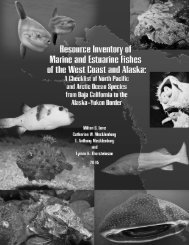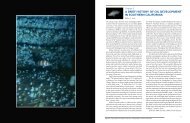Reproductive Ecology and Body Burden of Resident ... - The Love Lab
Reproductive Ecology and Body Burden of Resident ... - The Love Lab
Reproductive Ecology and Body Burden of Resident ... - The Love Lab
You also want an ePaper? Increase the reach of your titles
YUMPU automatically turns print PDFs into web optimized ePapers that Google loves.
northeast Santa Cruz Isl<strong>and</strong> site (Pelican) in 2002. In comparison, our seawater Ba Ca -1 values from 2005<br />
were relatively lower; Ba Ca -1 was 3.573 (SD=0.030, n=3) from our kelp rockfish natural site in the west<br />
Santa Barbara area <strong>and</strong> 3.424 (SD=0.240) from northeast Santa Cruz Isl<strong>and</strong>. Interestingly, otolith Ba Ca -1<br />
from fish collected at all sites sampled in our study were substantially lower than Ba Ca -1 sampled from the<br />
outermost material <strong>of</strong> kelp rockfish otoliths by Warner et al. (2005). This suggests that interannual differences<br />
in ambient Ba may affect otolith Ba on a regional scale (Santa Barbara Channel), <strong>and</strong> further study is<br />
needed to examine the temporal consistency <strong>of</strong> a platform “fingerprint.”<br />
We did not expect to find lower concentrations <strong>of</strong> Ba in otoliths <strong>of</strong> Pacific s<strong>and</strong>dab from natural areas<br />
compared to platforms. Pacific s<strong>and</strong>dab at the platforms are in proximal contact with drilling discharges in<br />
sediments <strong>and</strong> are opportunistically preying on such benthic infauna as polychaetes, as well as such benthic,<br />
epibenthic, <strong>and</strong> water column organisms including shrimps, gammarid amphipods, mysids, euphausiids,<br />
squids, <strong>and</strong> fishes (Allen 1982; Allen et al. 2002). Individuals <strong>of</strong> this species probably do not make large-scale<br />
movements as implied from regional surveys <strong>of</strong> chlorinated hydrocarbon contamination in the Southern<br />
California Bight (Schiff <strong>and</strong> Allen 2000).<br />
Drilling discharges consist <strong>of</strong> muds <strong>and</strong> cuttings that are generated during the drilling <strong>of</strong> a new well.<br />
Barite is a major constituent <strong>of</strong> the water-soluable drilling muds that are used on platforms <strong>of</strong>f Southern<br />
California (Raco 1994, Steinberger et al. 2005). Drill cuttings are particles <strong>of</strong> crushed sedimentary rock<br />
produced in the process <strong>of</strong> drilling. Of the total estimated metals discharged, barium accounted for 96%,<br />
lead 1.9%, <strong>and</strong> zinc 1.5% (Raco 1994). Well drilling <strong>and</strong> the associated discharges are intermittent from individual<br />
platforms <strong>and</strong> vary in quantity. For example, drill cuttings <strong>and</strong> mud were discharged by Platforms<br />
Gail, Habitat, Irene, Gilda, C, <strong>and</strong> B in 1990 (Raco 1994); Platforms Harmony, Heritage, Gail, Eureka, Gilda,<br />
C <strong>and</strong> Hermosa in 1996; <strong>and</strong> Platforms Hondo, Heritage, Hermosa, Harvest, Hidalgo, <strong>and</strong> Hillhouse in 2000<br />
(Steinberger et al. 2005).<br />
<strong>The</strong> barium load in sediments is a sensitive <strong>and</strong> persistent indicator <strong>of</strong> drilling activities at platforms.<br />
Barium was the only element among Ag, As, Cd, Cr, Cu, Hg, Ni, Pb, V, <strong>and</strong> Zn that changed significantly<br />
during a study conducted at Platform Hidalgo before during <strong>and</strong> after drilling had stopped (Steinhauer et<br />
al. 1994). During drilling, barium concentrations in surface sediments increased 30-40% above background.<br />
After drilling stopped, barium in sediments decreased, but after 1.5 years at the end <strong>of</strong> the study, surface<br />
sediments were approximately 20% higher than pre-drilling concentrations.<br />
If Ba has accumulated in sediments from historic drilling activities, then our results indicate that the<br />
Ba concentration in otoliths <strong>of</strong> Pacific s<strong>and</strong>dab residing at platforms is not a sensitive indicator. A possible<br />
explanation for the higher concentration <strong>of</strong> Ba in otoliths <strong>of</strong> Pacific s<strong>and</strong>dab from natural areas than from<br />
platforms are difficult to infer. <strong>The</strong> availability <strong>of</strong> Ba in seawater will decline due to the precipitation <strong>of</strong> Ba<br />
as barite in the presence <strong>of</strong> sulfate in high concentrations. If sulfate concentrations in bottom waters were<br />
higher at platforms than natural sites, then it is plausible that ambient Ba available for uptake by fish was<br />
more concentrated at the natural sites, <strong>and</strong> we were unable to detect this difference using our seawater sampling<br />
method.<br />
We found that s<strong>and</strong>dab otolith Mn significantly differed among areas; otolith Mn Ca -1 was higher<br />
among the two easternmost areas within the Channel <strong>and</strong> the Southern California Bight area than the three<br />
westernmost areas. We did not find a significant relationship between otolith Mn Ca -1 <strong>and</strong> seawater Mn Ca -1 ;<br />
however, Campana (1999) suggested that the Mn concentration in otoliths is likely to reflect Mn in ambient<br />
waters, because Mn is a trace metal that probably is not regulated to any significance in fishes. Studies<br />
indicate that differences in otolith Mn Ca -1 among locations may be related to the unconservative behavior<br />
<strong>of</strong> Mn in ambient waters due to redox reactions.<br />
Dissolved Mn (Mn +2 ) rapidly can become unavailable when it is oxidixed <strong>and</strong> scavenged onto particles<br />
in the aquatic environment (Sunda <strong>and</strong> Huntsman 1987). In laboratory studies testing effects <strong>of</strong> tempera-<br />
62




